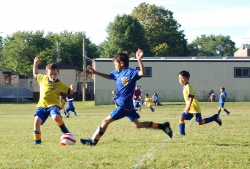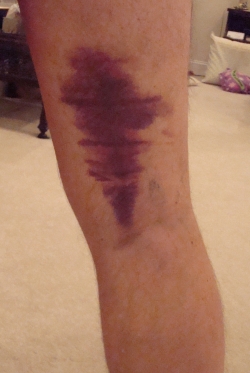It's late in the second half, and your team has the ball. You run down the field, shoot, score, then ouch! What happened? Most of use know about broken bones, but do you know about the ways we can hurt our muscles?

No one can stop me now!
Jarek Tuszyński / CC-BY-SA-3.0, CC BY-SA 3.0 , via Wikimedia Commons
The strong one on the back of your upper leg may have a tiny tear. This can happen when you turn or twist suddenly, which is why some people call it a "pulled muscle." It also can happen if you do not warm up well before playing soccer or if you do the same moves over and over again without a rest. The more you warm up before exercising, the safer it will be for your body to stretch and pull. Your legs, arms and back are most likely to be hurt in this way. You may have pain, feel weak, and may not be able to kick your leg very high. A strain is a small tear in your muscle or tendon.

This feels like more than a strain.
Jabarnes at English Wikipedia, Public domain, via Wikimedia Commons
However, if you are up and around after a few minutes of rest, you likely do not have a strain. Sometimes your muscles become tight when you do not want them to. The tightness and pain can last for a few minutes and then go away. Sometimes this happens when your body is really tired, like during the second half of a game, or when you have not had enough water to drink. Your best bet is to rest and drink water until it feels better. A cramp is when a muscle tightens up so much that it hurts. Your body does this without you telling it to. Ouch!
Your team is excited because your star player just had her cast taken off. She is ready to play now that her bone has healed, right? Guess again. While her bone was broken, the doctor put her arm in a cast where it could not move for a long time. If you do not use them, your muscles will slowly get smaller. Over several months, her arm muscles became weaker and smaller. It may take several weeks or longer for them to become strong again! Atrophy is when muscles are not used and grow weaker and smaller over time.
So far, we have talked about what can happen to muscles in healthy bodies, but things can also go wrong in the directions for our bodies. Our body has many different parts, and all of these parts are made from the directions in our genes. Sometimes, something goes wrong in these directions that makes muscle cells die over time. There are many different forms of this sickness, but the form we see the most is found in children around age four. At first, they will become weak, but by the time they are 12, they may be in a wheelchair. There is no cure today, but doctors try to keep the child's body strong through medicine and exercise. Muscular dystrophy is a genetic disease that makes muscles weaker and smaller over time. This can even lead to death.
Most of the time our muscles do their part, moving our bodies when our brain tells them to. Sometimes, however, they fall short. It might be because they are too tired from running all morning, or perhaps we did not drink enough water at half time. Or, maybe we had a broken bone, so we did not use them, and they became weak. Sometimes we don't have a choice and are born with muscles that become weak and small. In most cases our bodies will get better over time, and we can get back to the things we like to do. References:
"Muscular dystrophy." CareNotes. 1 May 2012. Web. 18 Jan. 2013.
"Muscle strain." AltCareDex Medicine Modality. Aug. 2012. Web. 18 Jan. 2013.
Nagel, Rob and Rebecca Frey. "The Muscular System." Body by Design: From the Digestive System to the Skeleton. Betz Des Chenes, Editor. Online Edition. Farmington Hills, MI: UXL, 2007. Web. 18 Jan. 2013.
Quercia, Nada and Monique Laberge. "Muscular dystrophy." The Gale Encyclopedia of Medicine. Ed. Laurie J. Fundukian. 4th ed. Detroit: Gale, 2011. 6 vols. Web. 21 Jan. 2013."Questions and answers about sprains and strains." National Institute of Arthritis and Musculoskeletal and Skin Diseases. 5 Jun. 2012. Web. 18 Jan. 2013.
Robinson, Richard and Laura Jean Cataldo. "Muscle spasms and cramps." The Gale Encyclopedia of Medicine. Ed. Laurie J. Fundukian. 4th ed. Detroit: Gale, 2011. 6 vols. Web. 18 Jan. 2013.
Rouzier, Pierre. "Muscle spasms." Clinical Reference Systems. 1 Feb. 2010. Web. 18 Jan. 2013.